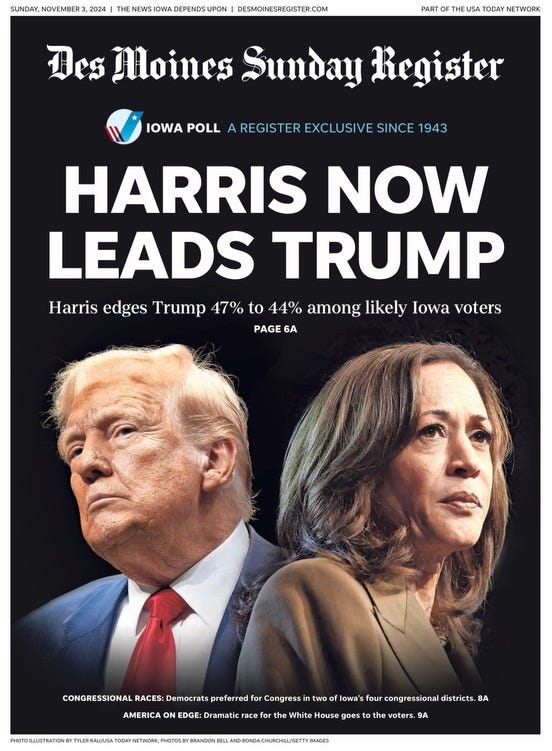Neverland
A Halloween theme that also applies to Tuesday!
I’ll get to politics later in this piece, but first some pictures to ease the soul!
It’s our first Halloween as a family. I’ve always loved the story of Peter Pan, and in some ways I too fought growing up, living my 20s in my 40s here in NYC before finally deciding to get a bit more serious with my life.
It took many years to get to this point, but it’s been worth it. Here’s little Riley as Tinkerbell, looking as cute as any Gerber baby!
Maggie, who now helps with the planning of most things in my life, created this Neverland ensemble. I particularly love Windsor as the Crocodile. But unlike that croc, she never “ticks” me off!
Riley has begun smiling at me, which is the most magical thing in the world. I can’t wait to hear what she’ll have to say!
Of course, Windsor perfected her heart-stealing smile long ago. And she’s such a good sport!
Not so much my kitty Shade, who was supposed to be Captain Hook. More like Captain Claw here! This is the best we could do with him. He’s 11 years old, so we cut him a lot of slack…
Of course, Family Halloween comes on the eve of a big election, the most important in our lifetimes, one that will finally finish up on Tuesday. And you may have heard some very conflicting stories about the polling in the last 24 hours, and it’s enough to drive anyone batty! So let’s get some clarity.
A shocker in Iowa
Iowa wasn’t on anyone’s presidential radar. After all, beyond its role in the primaries, it’s not an Electoral College vote rich state, with just six to award. But Iowa does have one thing other states don’t: A nationally regarded local pollster named Ann Selzer.
Some big news hit like a thunderbolt last night when the Selzer poll, commissioned by the Des Moines Register per usual and considered the gold standard in the industry, dropped. It covered the presidential race in Iowa.
Here are some things to know.
The Selzer poll’s final results before the election have rarely been off. The last time was in 2018, by five. Here is Selzer’s track record over the last few cycles going back a dozen years, per Cook Political’s Matthew Klein:
2022 Senate: R+12 (R+12)
2020 President: R+7 (R+8)
2020 Senate: R+4 (R+7)
2018 Governor: D+2 (R+3)
2016 President: R+7 (R+9)
2014 Senate: R+7 (R+8)
2012 President: D+5 (D+6)
Selzer knows Iowa very well, and every politico and election wonk in the country was on edge awaiting her final Iowa presidential poll last night at 7 p.m. That’s because any movement would tell us a lot about how neighboring states like Wisconsin might go.
When her poll came out, there was a collective gasp, and my texts started blowing up. She had Kamala Harris winning by three points. Here’s the headline in Des Moines today as people were waking up:
That’s a seven point shift since September, when Trump was up by four. How did this happen? A few key things underneath those top line numbers, per WaPo reporter Matt Viser:
Independent women back Harris by a 28-point margin, 57% to 29%
Senior women support her by a more than 2-to-1 margin, 63% to 28%
97% of Dems support Harris, while only 89% of Republicans support Trump
(Emphases mine.)
If Selzer’s numbers are correct—and that’s hard for many to wrap their heads around—that would mean Harris is cruising to a victory in the other Great Plains states, including Wisconsin. After all, if Harris is really winning over white women by over 20 percent, that number would carry over to the Blue Wall battlegrounds. It would mean all the other polls missed something big.
It also would mean the rural vote in these states for Harris will hold up, as Pennsylvania election guru Joshua Smithley’s analysis of district level polling indicated:
Do I personally believe Harris will win Iowa? No. This feels like a bit of an overstatement, and it could just be picking up some last minute enthusiasm. But you know what? It doesn’t matter. Even if Selzer is off by 5-7 points, that’s still a big problem for Trump and the GOP. Trump won Iowa by around nine points in 2020. A shift of 5-7 points in Iowa would spell trouble.
Selzer also has two congressional races in Iowa being won by Democrats. Currently, all four seats are held by Republicans. Wins in Iowa by Democratic House contenders would also be very, very bad news for the House GOP Conference and Speaker Johnson’s hopes of remaining in his job.
Squishing the numbers
But how could this poll produce such a different result than, say, those agita-inducing NYT polls which consistently show a tie, both nationally and in the battlegrounds?
Without getting too far into the weeds, it’s important to understand that most pollsters, including the Times, massage their numbers. Sometimes a lot. That’s because when pollsters take a sample of the population, they often wind up getting a non-representative panel of folks, at least politically speaking.
For example, after you finally get through to 1,000 registered voters who actually complete a poll, 55 percent of them might be Democrats. After all, these voters are somewhat easier to find and reach than conservative, low propensity GOP voters.
So what do most pollsters do? They squish the set so that it looks like how they believe the electorate is going to look in 2024. Often they use models from Gallup or Pew Research to create a “representative” set of voters. Gallup believes there are a few percent more Republicans than Democrats in the electorate, for example. Depending on which model of the electorate a pollster uses, that can cause big swings in their final squished result. One recent study showed that assumptions like this can swing a panel of voters by a whopping eight points.
As George Conway noted, the fact that “All polling is based on modeling from past elections” is something most Americans don’t understand:
It’s a necessity of public-opinion research. Because if you call up 100,000 people randomly, you’re going to get a good sample of people who answer their phones—not a good sample of the adult population generally, or the pool of registered voters. And you certainly don’t necessarily end up with a sample that adequately represents the people who will actually cast votes—because the identity of those people can’t be known until after they vote. (Also worth noting is that if you randomly dial 100,000 numbers these days, you might only get a few hundred responses—and that doesn’t help, either.)
Selzer doesn’t do political party squishing. She’ll weight by certain demographics such as gender, but she doesn’t insert her own opinion into what the electorate will look like politically in the end. She lets the voters tell her.
Whether that’s a better way to do things is an open question. Polling has become such a herd mentality, and so many pollsters are afraid of underestimating Trump, that we’re seeing what I view as very conservative assumptions being used. Again, those could be right, but having the polls depend largely on the pollsters’ own views seems counterproductive and wrong.
This Selzer poll is one piece of information, but it isn’t alone. Two other recent polls confirm something is moving in the Midwest. They still have Trump up, but it’s moving away from him:
Ohio: 49/46 (Trump leads, but a 5 point swing to Ds from 2020)
Kansas: 48/43 (Trump leads but a 9 point swing to Ds from 2020)
Comparable swings in PA, MI and WI? We’ll have to see. To me, that would make sense.
Reasons to hope
In just two and a half days, polls will close. I’m going to leave you today with some reasons to hope, which I have been posting on social media. Here was one of my posts from yesterday, in case you missed it:
* * *
Reasons for Hope #6:
There’s not much that election analysts agree on when it comes to the vote so far, except for a few key points:
1) Turnout looks like it will be around 2020’s numbers, especially in the battleground states. It may exceed 2020 turnout there.
2) There is a 10-point gender gap in the early vote in favor of women, even though Republicans and Democrats are voting in around the same numbers wherever there is in-person early voting.
3) The unaffiliated / independent vote contains a lot of first time voters who tend to favor the Democratic candidate.
4) Democrats are executing on their ground game and knocking on thousands of doors per minute currently. Republicans have no similar system in place.
These are all good indications for Democrats and a reason I would much rather be us than them! One way to think about it is to consider how pessimistic you might feel if a lot of this were reversed.
For example, if it were the case that turnout looked anemic, there were more men voting than women, the newly registered were mostly voting for Trump, and Democrats were almost nowhere to be seen on the ground in the battleground states… how sick to your stomach would you feel?
Republicans can point to close polling. And that’s about it. In every other measure, they are trailing. To me, that indicates a polling miss that overstates Trump support and understates Harris support, but I suppose we won’t know that until the votes are counted. Until then, know that everything that is supposed to be happening is happening: high turnout, motivated women, young people breaking our way, and a mighty, mighty ground game backed by tens of thousands of volunteers.
Voters across America, especially women, are saying “never” to Trump. So let’s send him back over to Neverland, never to return. Let’s go win this.
Jay









Riley is adorable. Thanks for the analysis. I think the national polling is a disaster and they are embarrassingly underestimating the power of pissed-off women. I think it’s Kamala in a landslide, at least, that’s what I think in the moments when I’m not immobilized by fear.
I love the family's first Halloween pictures. Savor it all. ❤️